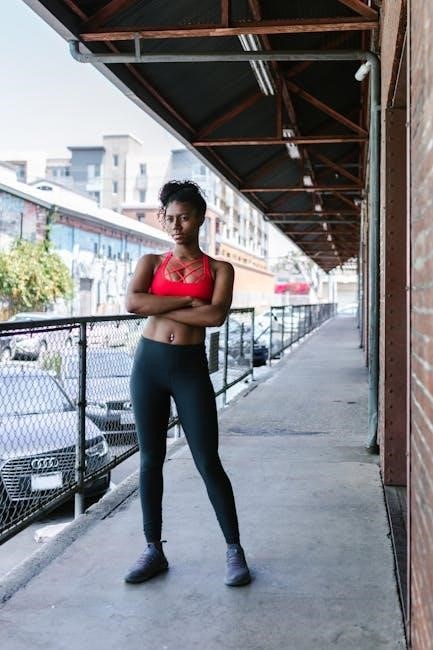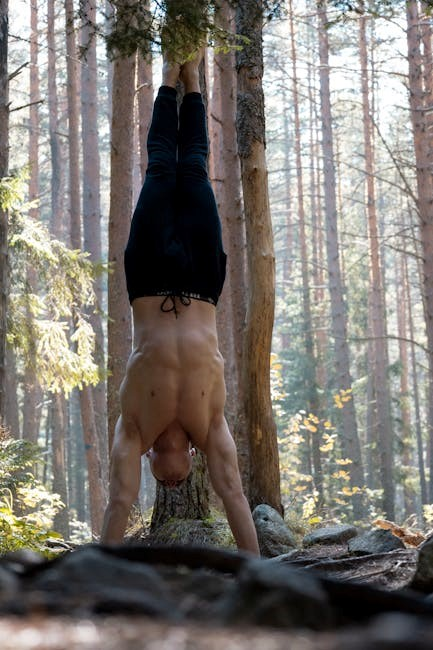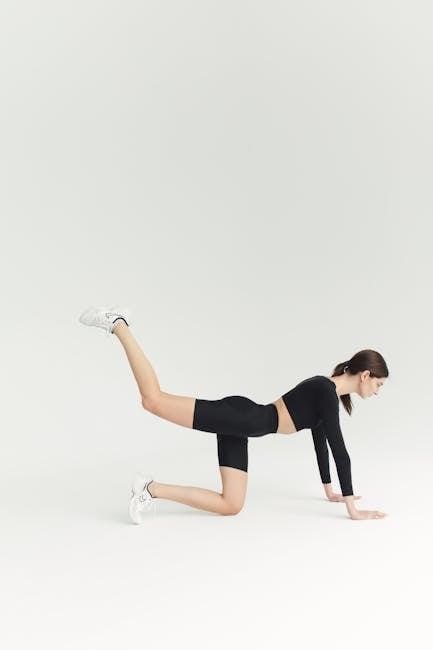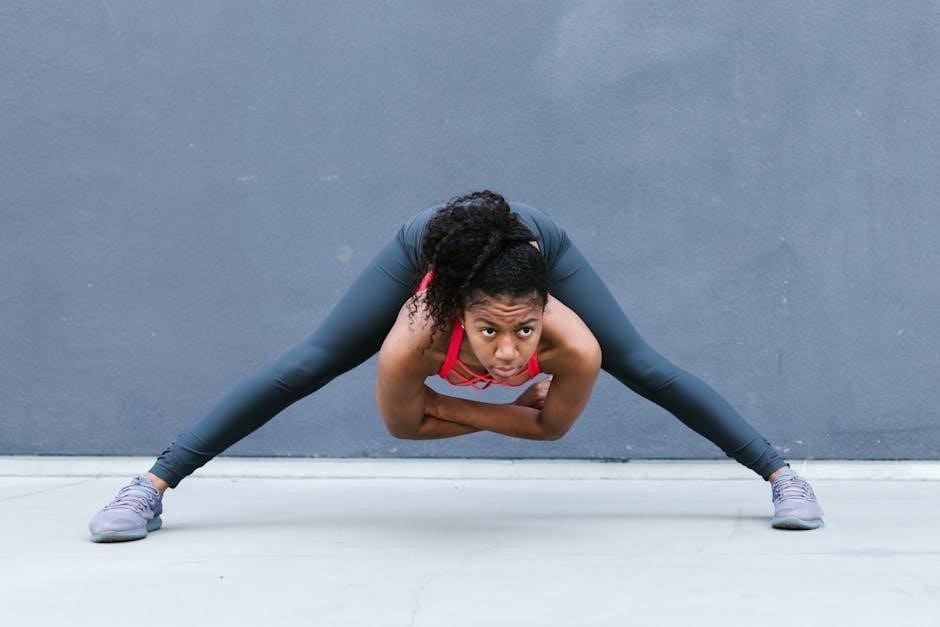30-Minute Bodyweight Workout PDF: A Comprehensive Guide
Embark on a transformative fitness journey with our comprehensive guide to 30-minute bodyweight workouts! This resource provides an accessible and effective way to build strength, burn fat, and improve overall fitness, all without needing equipment. Perfect for home workouts!
Bodyweight training offers a versatile and convenient approach to fitness, utilizing your own weight as resistance. It’s an accessible method, requiring no equipment, making it ideal for home workouts or training on the go. This form of exercise encompasses a wide range of movements that engage multiple muscle groups simultaneously, promoting functional strength and overall body conditioning.
Key exercises include squats, push-ups, lunges, planks, and various core exercises. These movements not only build muscle strength and endurance but also enhance balance, coordination, and flexibility. Bodyweight training is highly adaptable, allowing for modifications and progressions to suit individual fitness levels and goals.
Whether you’re a beginner or an experienced athlete, bodyweight exercises can be tailored to challenge your body effectively. The focus is on proper form and controlled movements to maximize results and minimize the risk of injury. Embrace the simplicity and effectiveness of bodyweight training for a holistic fitness experience.
Benefits of a 30-Minute Bodyweight Workout
A 30-minute bodyweight workout offers a plethora of benefits for both physical and mental well-being. Firstly, it’s incredibly time-efficient, fitting seamlessly into busy schedules. These workouts can be performed anywhere, anytime, eliminating the need for gym memberships or specialized equipment.
Bodyweight exercises improve cardiovascular health, increase muscular strength and endurance, and enhance flexibility and balance. Regular sessions can lead to weight loss, improved body composition, and boosted metabolism. Moreover, these workouts promote functional fitness, making everyday activities easier and more comfortable.
The mental benefits are equally significant. Exercise releases endorphins, which reduce stress, improve mood, and enhance cognitive function. Bodyweight training, in particular, can boost self-esteem and confidence as you witness your body’s capabilities expand. The accessibility and adaptability of these workouts also make them a sustainable and enjoyable fitness option. Incorporating 30-minute bodyweight workouts into your routine is a powerful step towards a healthier, happier you.
Sample 30-Minute Bodyweight Workout Routine
This sample routine is designed to provide a full-body workout in just 30 minutes. Start with a 5-minute warm-up of light cardio and dynamic stretching. Then, move into the main circuit, performing each exercise for 40 seconds followed by 20 seconds of rest. Complete three rounds of the circuit.
The circuit includes exercises like squats, push-ups, lunges (alternating legs), plank, and jumping jacks. Cool down with 5 minutes of static stretching, holding each stretch for 30 seconds. For squats, focus on maintaining good form, keeping your back straight and chest up. Push-ups can be modified on your knees if needed. Lunges should be deep and controlled, ensuring your front knee doesn’t extend past your toes. The plank engages your core, so keep your body in a straight line from head to heels. Jumping jacks elevate your heart rate and improve cardiovascular fitness.
Remember to stay hydrated and listen to your body, adjusting the intensity as needed.

Warm-up Exercises (5 minutes)
A proper warm-up is crucial to prepare your body for the workout ahead, reducing the risk of injury and improving performance. Dedicate 5 minutes to these dynamic exercises. Start with 2 minutes of light cardio, such as jogging in place, jumping jacks, or high knees, to increase blood flow and heart rate.
Follow with dynamic stretches for 3 minutes. Include arm circles (forward and backward), leg swings (forward and sideways), torso twists, and cat-cow stretches. Arm circles loosen the shoulder joints, leg swings improve hip mobility, torso twists warm up the core, and cat-cow stretches increase spinal flexibility. Perform each dynamic stretch for 30 seconds, focusing on controlled movements and engaging the targeted muscles.
The warm-up should leave you feeling slightly warmer and more mobile, ready to tackle the workout. Avoid static stretching during the warm-up, as it can temporarily reduce muscle strength. Instead, save static stretches for the cool-down.

Workout Circuit (20 minutes)
This 20-minute circuit is designed to target all major muscle groups, providing a full-body workout. Perform each exercise for 40 seconds, followed by 20 seconds of rest. After completing all exercises in the circuit, rest for 1 minute before repeating. Aim for 3-4 rounds of the circuit.
The exercises include squats, push-ups, lunges (alternating legs), plank, and jumping jacks. Squats work the quads, glutes, and hamstrings. Push-ups target the chest, shoulders, and triceps. Lunges strengthen the quads, glutes, and hamstrings while improving balance. The plank engages the core muscles. Jumping jacks elevate the heart rate and improve cardiovascular fitness.
Focus on proper form throughout the workout. Maintain a straight back during squats and lunges. Keep your core engaged during the plank. Modify exercises as needed to maintain good form. If push-ups are too challenging, perform them on your knees. Listen to your body and take breaks when necessary. Stay hydrated by drinking water before, during, and after the workout.
Cool-down and Stretching (5 minutes)
After your workout, a 5-minute cool-down and stretching routine is crucial for muscle recovery and flexibility. Begin with light cardio, such as walking in place, for a couple of minutes to gradually lower your heart rate. This helps prevent dizziness and allows your body to transition back to a resting state.
Follow the cardio with static stretches, holding each stretch for 30 seconds. Focus on major muscle groups worked during the workout, including quads, hamstrings, glutes, chest, shoulders, and triceps. Examples include quad stretches, hamstring stretches, glute bridges, chest stretches against a wall, shoulder stretches across the body, and tricep stretches overhead;
Stretching increases blood flow to the muscles, reducing soreness and improving flexibility. Breathe deeply and relax into each stretch. Avoid bouncing or forcing the stretch. If you feel any pain, ease up on the stretch. Regular stretching can improve your range of motion and prevent injuries. Make cool-down and stretching an essential part of your fitness routine!
Modifications and Progression
Adapting your bodyweight workout to your fitness level is key for sustainable progress. If you’re a beginner, modify exercises to reduce intensity. For example, do push-ups on your knees instead of your toes, or perform squats with a chair for support. Focus on maintaining good form before increasing the difficulty. Listen to your body and avoid pushing yourself too hard.
As you get stronger, progress by increasing the number of repetitions or sets, reducing rest time, or trying more challenging variations of exercises. For instance, transition from knee push-ups to standard push-ups, or from regular squats to jump squats. You can also incorporate plyometric moves to increase the intensity.

Another way to progress is to focus on unilateral exercises, which work one side of the body at a time. Examples include lunges, single-leg squats, and single-arm planks. These exercises challenge your balance and coordination, and they can help identify and correct muscle imbalances. Consistency and gradual progression are essential for achieving your fitness goals!
HIIT Bodyweight Workout
High-Intensity Interval Training (HIIT) is a fantastic way to maximize your workout in a short amount of time. A HIIT bodyweight workout involves alternating between short bursts of intense exercise and brief recovery periods. This approach elevates your heart rate, burns calories, and improves cardiovascular fitness.
A typical HIIT bodyweight routine might consist of exercises like burpees, jump squats, mountain climbers, and push-ups performed for 30-40 seconds, followed by 15-20 seconds of rest. Repeat this cycle for several rounds, adjusting the duration and intensity as needed. The key is to push yourself to your maximum effort during the work intervals.
HIIT workouts are incredibly versatile and can be tailored to suit any fitness level. Beginners can start with shorter work intervals and longer rest periods, while more advanced individuals can increase the intensity and duration. Remember to warm up properly before starting your HIIT session and cool down afterwards to prevent injuries and promote recovery. This will help you achieve fitness goals.
EMOM Bodyweight Workout
EMOM, or Every Minute On the Minute, is a challenging and efficient workout structure. In an EMOM bodyweight workout, you perform a specific number of repetitions of an exercise within one minute. Any remaining time within that minute serves as your rest period before moving on to the next exercise.
For example, you might perform 15 push-ups at the start of the minute, and then rest for the remainder of that minute. At the start of the next minute, you move on to another exercise, such as 20 squats. This continues for a set number of rounds or a predetermined time, like 30 minutes.

EMOM workouts are excellent for building strength, improving conditioning, and enhancing mental toughness. They require focus and discipline to maintain consistent effort throughout the workout. You can select a variety of bodyweight exercises to target different muscle groups, creating a full-body workout. Adapt the number of repetitions based on your fitness level, ensuring that you can complete the reps with good form within the minute to maximize the workout.
Full Body Bodyweight Workout
A full-body bodyweight workout is an efficient way to target all major muscle groups using only your body weight for resistance. This type of workout is highly accessible and can be performed anywhere, making it a convenient option for those with limited time or access to equipment.
A well-structured full-body bodyweight routine typically includes exercises that work the legs, core, chest, back, and arms. Example movements include squats, lunges, push-ups, planks, and rows using a sturdy surface. By combining these exercises in a circuit or interval format, you can elevate your heart rate and burn calories while simultaneously building strength and endurance.
The key to an effective full-body bodyweight workout is to focus on proper form and controlled movements. This ensures that you are engaging the correct muscles and minimizing the risk of injury. Additionally, varying the tempo, repetitions, and sets can help to challenge your muscles and prevent plateaus. Whether you are a beginner or an experienced fitness enthusiast, a full-body bodyweight workout can be a valuable addition to your fitness routine.
Advanced Bodyweight Exercises
Once you’ve mastered the fundamental bodyweight exercises, it’s time to elevate your training with advanced variations that demand greater strength, stability, and coordination. These exercises push your limits and unlock new levels of fitness.
Advanced bodyweight movements often involve complex multi-joint actions and increased range of motion. Examples include pistol squats, which require exceptional balance and leg strength; handstand push-ups, targeting the shoulders and core; and muscle-ups, combining a pull-up with a dip for upper body power. Other challenging options include plyometric exercises like clapping push-ups and jump squats, which enhance explosiveness.
Before attempting advanced bodyweight exercises, ensure you have a solid foundation in basic movements and possess adequate core stability. Progress gradually, focusing on proper form and control to prevent injuries. Consider working with a qualified fitness professional to learn correct technique and receive personalized guidance. Incorporating these advanced exercises into your routine will challenge your body and help you achieve peak physical condition.
